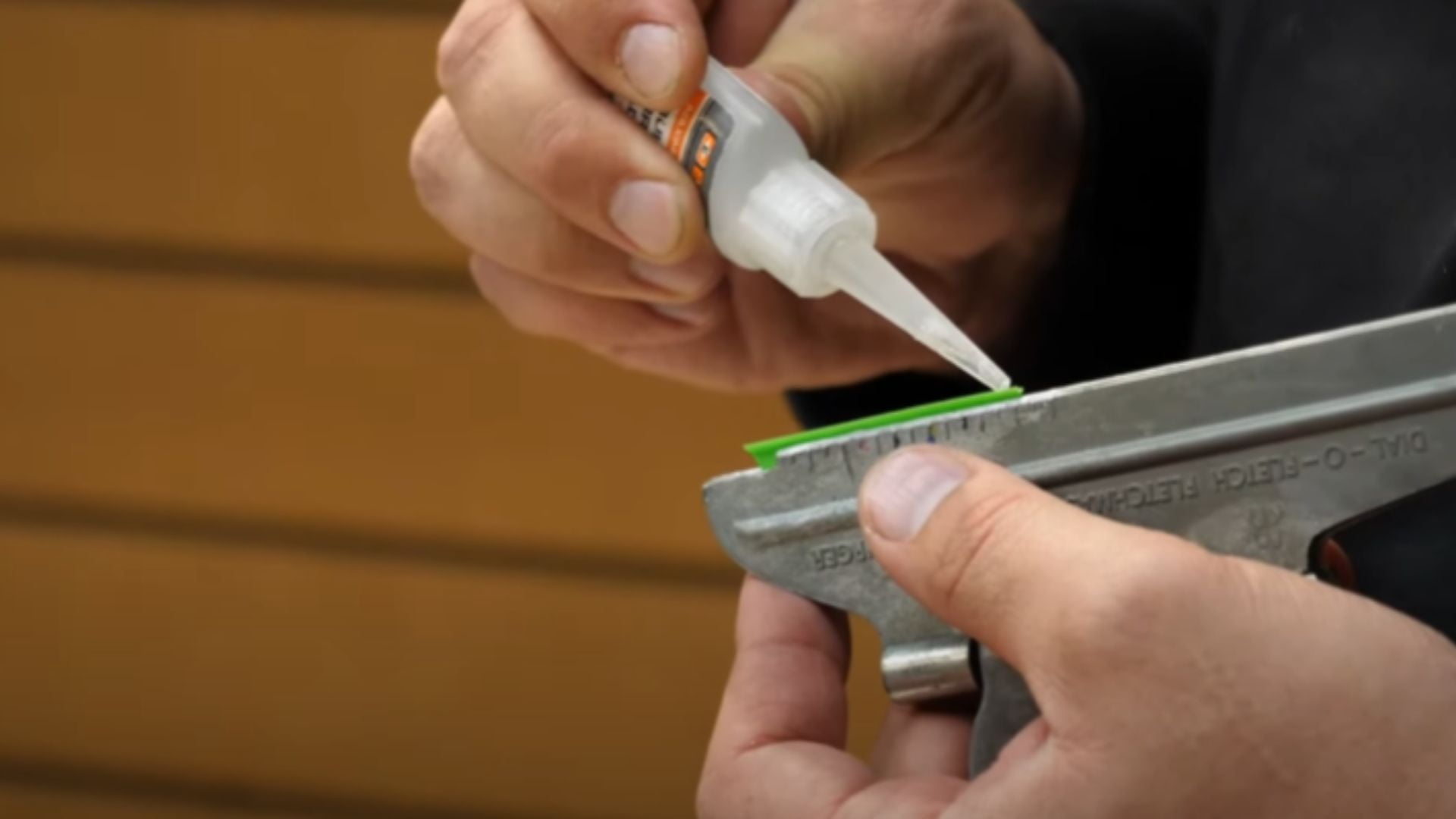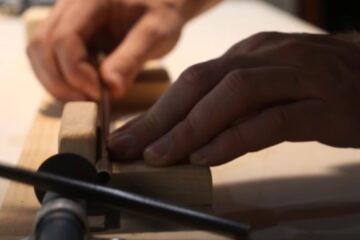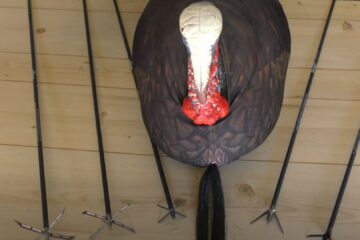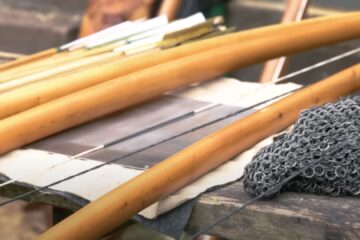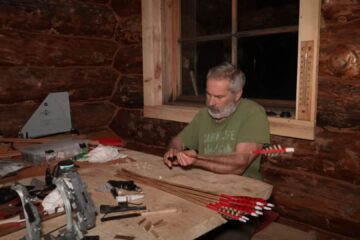Fletching aluminum arrows involves attaching feathers or vanes to the shaft for better stability and accuracy. Aluminum arrows are lightweight and durable, making them popular among archers of all skill levels.
The fletching process requires precision and attention to detail to ensure proper flight and performance. By following the correct techniques and using the right materials, you can create well-fletched aluminum arrows that will improve your shooting experience. We will discuss the steps and considerations involved in fletching aluminum arrows.
Whether you are a beginner or an experienced archer, this guide will provide you with the necessary information to fletch your arrows effectively and enhance your shooting skills.
The Importance Of Fletching In Arrow Precision
Fletching is crucial for enhancing the precision of aluminum arrows, ensuring accurate flight, and hitting the target with optimal efficiency. By providing stability and control, fletching plays a vital role in maximizing arrow performance.
Understanding The Role Of Fletching In Arrow Flight
Arrow fletching refers to the feathers or vanes attached to the rear end of an arrow shaft. These small components play a crucial role in ensuring arrow precision and accuracy. Understanding the impact of fletching on arrow flight is essential for archers seeking optimal performance.
Let’s delve into the specifics.
- Fletching Provides Stability:
- The fletching acts as a stabilizer, counterbalancing the weight of the arrowhead and ensuring a straight trajectory.
- It prevents the arrow from veering off course during flight by minimizing rotation and maintaining stability.
- Fletching Controls Spin:
- The vanes or feathers create drag, which counteracts the rotational force of the arrow.
- By controlling spin, the fletching helps maintain a consistent flight path, reducing the chances of erratic arrows.
- Fletching Influences Arrow Speed:
- The design and configuration of the fletching impact the arrow’s forward velocity.
- The right combination of length, shape, and material can minimize aerodynamic drag, leading to increased velocity.
The Impact Of Fletching On Accuracy And Stability
When it comes to accuracy in archery, fletching plays a significant role. Let’s explore how it affects the stability and precision of arrow flight.
- Arrow Stability:
- Fletching enhances arrow stability by providing drag and resistance to rotation.
- The vanes or feathers keep the arrow on a straight, predictable path from release to target.
- Improved Accuracy:
- Correctly fletched arrows are more accurate, as the fletching ensures consistent flight characteristics.
- A well-fletched arrow minimizes uncertainties caused by wind, enabling archers to hit their mark consistently.
- Wind Resistance:
- Fletching acts as a control surface, allowing an archer to compensate for crosswinds and maintain accuracy.
- The feathers or vanes conveniently counteract the effects of these external factors, increasing shot precision.
Fletching significantly impacts arrow flight. By providing stability, controlling spin, and influencing arrow speed, it contributes to both accuracy and stability. Understanding the role of fletching allows archers to optimize their equipment and improve their overall performance on the range or in the field.
Types Of Fletching For Aluminum Arrows
Aluminum arrows offer different types of fletching for optimal performance. Explore the various options available to enhance accuracy and stability during archery.
Fletching Aluminum Arrows:
When it comes to fletching your aluminum arrows, choosing the right material is crucial. Two popular options for fletching are vanes and feathers. Each material has its own set of pros and cons, allowing you to make an informed decision based on your needs and preferences.
Comparing Vanes And Feathers For Fletching Aluminum Arrows:
**Vanes**:
- Vanes are made from sturdy synthetic materials like plastic or vinyl.
- They are known for their durability and ability to withstand harsh weather conditions.
- Vanes offer consistent arrow flight and stability due to their uniform shape.
- These fletchings are popular among target archers and hunters alike.
- Vanes are available in a wide range of colors, allowing you to add a personal touch to your arrows.
- However, vanes can be noisier than feathers when they come into contact with the bow’s arrow rest or the air.
**Feathers**:
- Feathers are the traditional choice for fletching arrows.
- They are lightweight, flexible, and have been used for centuries.
- Natural feathers offer a traditional and authentic look to your arrows.
- Feathers provide excellent arrow stabilization and forgiving flight characteristics.
- They produce less noise compared to vanes during arrow release.
- However, feathers are more susceptible to damage from moisture and adverse weather conditions.
- They may require more frequent replacement compared to vanes.
Consider the following pros and cons of these fletching materials before making your decision:
Pros of vanes:
- Durable and weather-resistant.
- Ensures consistent arrow flight and stability.
- Popular among target archers and hunters.
- Various color options available for customization.
Cons of vanes:
- Can be noisier when coming into contact with the bow’s arrow rest or the air.
Pros of feathers:
- Lightweight and flexible.
- Traditional and authentic look.
- Provide excellent stabilization and forgiving flight.
- Produce less noise during arrow release.
Cons of feathers:
- More susceptible to damage from moisture and adverse weather conditions.
- May require more frequent replacement.
Ultimately, the choice between vanes and feathers for fletching your aluminum arrows depends on your specific needs, shooting style, and personal preference. Take into account factors such as durability, weather resistance, noise level, and aesthetics to make an informed decision.
Happy fletching!
Choosing The Right Fletching Size And Shape
Choosing the right fletching size and shape is essential for aluminum arrows. It helps improve stability and accuracy, ensuring better performance during shooting. Optimizing fletching can lead to more precise and predictable flight paths.
Fletching Aluminum Arrows:
When it comes to fletching aluminum arrows, choosing the right size and shape is crucial for achieving optimal arrow trajectory. The fletching, which refers to the feathers or vanes attached to the rear of the arrow, plays a significant role in stabilizing the arrow during flight.
In this section, we will explore the factors to consider when selecting fletching size and shape, as well as how different fletching sizes and shapes can affect arrow trajectory.
Factors To Consider When Selecting Fletching Size And Shape:
- Arrow Velocity: The size and shape of the fletching can impact the speed at which the arrow travels. Smaller fletching creates less drag and allows the arrow to achieve higher velocities. On the other hand, larger fletching provides better stability but may sacrifice some speed. Consider your specific needs and preferences when choosing fletching size and shape.
- Wind Conditions: Wind can significantly affect arrow flight. Larger fletching provides more surface area, increasing the arrow’s resistance to wind drift. If you often shoot in windy conditions, opting for larger fletching can help improve your accuracy. Conversely, smaller fletching is less affected by wind, making it suitable for shooting in calmer environments.
- Arrow Spine: The spine, or stiffness, of your arrow shaft also influences fletching selection. If you have a stiffer arrow shaft, larger fletching can help compensate for the reduced arrow flex, ensuring stable flight. Conversely, if your arrow shaft is more flexible, smaller fletching may be sufficient to maintain stability.
- Intended Use: Consider whether you will be using your aluminum arrows for target shooting, hunting, or both. For target shooting, smaller fletching is often preferred as it reduces drag and improves accuracy. On the other hand, larger fletching is recommended for hunting as it enhances stabilization and forgiveness, increasing the chances of hitting the target.
How Different Fletching Sizes And Shapes Affect Arrow Trajectory:
- Parabolic Fletching: Parabolic fletching features a curved shape and is a popular choice among archers. It provides a good balance between stability and speed, making it suitable for various purposes. The curved design allows the arrow to quickly correct flight deviations, resulting in improved accuracy.
- Shield Fletching: Shield fletching has a unique shape resembling a shield, with a rounded front and a straight trailing edge. It offers a larger surface area than parabolic fletching, providing enhanced stability and resistance against wind drift. Shield fletching is commonly used for hunting, where precision is crucial.
- Straight Fletching: Straight fletching, as the name suggests, has a straight shape with no curvature. It is often preferred for target shooting due to its minimal drag and superior accuracy. Straight fletching offers less forgiveness compared to parabolic or shield fletching, but it excels in maintaining a consistent and predictable arrow flight.
Choosing the right fletching size and shape for your aluminum arrows requires careful consideration of various factors. Understanding how arrow velocity, wind conditions, arrow spine, and intended use can influence your selection is essential. Whether you opt for parabolic, shield, or straight fletching, each shape comes with its own advantages and is tailored to different shooting scenarios.
Select fletching that best aligns with your shooting style and goals to optimize your arrow’s trajectory and overall performance.
Fletching Techniques For Precision
Fletching aluminum arrows requires precise techniques to ensure accuracy and stability. Proper fletching not only enhances arrow flight but also improves overall shooting performance. Mastering these techniques is essential for archers looking to optimize their game.
Step-By-Step Guide To Fletching Aluminum Arrows:
To achieve precision in fletching your aluminum arrows, follow these step-by-step instructions:
- Prepare the arrow shaft:
- Start by cleaning the arrow shaft with a cotton cloth to remove any dirt or debris. This will ensure a smooth surface for attaching the fletchings.
- Choose the fletchings:
- Select the appropriate fletchings for your arrows based on their size, shape, and material. Popular options include feather fletchings or plastic vanes.
- Apply adhesive:
- Apply a small amount of arrow adhesive to the base of the first fletching. Be careful not to use too much glue, as it may result in a messy application.
- Position the fletching:
- Carefully position the fletching at the desired location on the arrow shaft. Make sure the feather or vane aligns with the correct orientation, which can be either helical or straight.
- Press firmly:
- Once the fletching is in place, press it firmly against the arrow shaft to ensure a strong bond with the adhesive. Hold it in position for a few seconds to allow the glue to set.
- Repeat for remaining fletchings:
- Repeat the adhesive application, positioning, and pressing steps for the remaining fletchings. Ensure consistent placement of each fletching to maintain accuracy.
- Allow drying time:
- Allow the glue to dry completely as per the manufacturer’s instructions before moving on to the next steps in arrow assembly or usage.
- Test for stability:
- After the glue has fully dried, gently tug on each fletching to test its stability. If any fletching feels loose, reapply adhesive and press firmly again.
- Trim excess fletching:
- If necessary, trim the excess length of the fletchings to achieve your desired arrow length. Use sharp scissors or a razor blade for precision trimming.
- Repeat for additional arrows:
- Follow the same steps for fletching the remaining aluminum arrows in your set, ensuring consistent and accurate placement.
Tips For Achieving Consistent And Accurate Fletching Placement:
To enhance your fletching techniques and ensure precise alignment every time, consider these helpful tips:
- Use a fletching jig: Invest in a fletching jig to ensure consistent positioning of the fletchings on your arrows. The jig holds the arrow securely, providing a stable base for fletching application.
- Mark the arrow shaft: Before fletching, mark the arrow shaft with a reference point to guide your placement. This helps achieve uniformity in fletching alignment.
- Maintain proper spacing: Position the fletchings evenly around the arrow shaft, maintaining an equal space between each fletching. This promotes aerodynamic stability and accurate flight.
- Check for straightness: Before attaching the fletchings, ensure that the arrow shaft is straight. Any bends or curves may lead to imprecise fletching placement and affect arrow performance.
- Practice consistency: Establish a consistent technique for applying adhesive, positioning the fletchings, and pressing them firmly onto the arrow shaft. Consistency leads to improved accuracy.
- Seek expert advice: If you are a beginner or seeking advanced tips, consult experienced archers or professionals who can provide valuable insights into fletching techniques specific to aluminum arrows.
By following these step-by-step instructions and adhering to the recommended tips, you can achieve precision in fletching your aluminum arrows. Remember, practice makes perfect, so keep refining your skills and experimenting with different fletching techniques to find what works best for you.
Happy fletching!
Fletching Maintenance And Repair
Fletching maintenance and repair are essential to ensure the optimal performance of aluminum arrows. Regularly inspecting and replacing damaged fletchings helps to maintain accuracy and consistency in arrow flight.
Maintaining and protecting fletching integrity:
- Keep the fletching clean and dry to prevent degradation and maintain accuracy.
- Avoid exposing fletching to extreme temperatures or direct sunlight, as this can cause warping and damage.
- Store arrows in a secure and upright position to protect the fletching from bending or crushing.
- Regularly inspect the fletching for any signs of wear or damage and take immediate action to prevent further issues.
Common issues and fixes for damaged fletching:
- Separated or loose fletching: Apply a suitable adhesive to reattach the fletching securely.
- Bent or creased fletching: Gently straighten bent fletching using your fingers or a straight edge.
- Feather damage: If a feather is torn or frayed, trim it to maintain consistency and balance in flight.
- Water-damaged fletching: Allow the fletching to dry completely before using it, as wet feathers can lead to inaccurate shooting.
Remember, maintaining and repairing fletching is essential for accurate arrow flight and consistent performance. By following these tips, you can prolong the lifespan of your fletching and avoid obstructions to your archery endeavors.
Fletching Tools And Materials
Fletching aluminum arrows requires the right tools and materials. From arrow fletching jigs to feathers and vanes, you’ll find everything you need to create high-quality arrows for your archery needs.
When it comes to fletching aluminum arrows, having the right tools and materials is essential for achieving high-quality results. Whether you’re a professional archer or a hobbyist, here are some recommendations for the tools and supplies you’ll need:
Essential Tools And Materials For Fletching Aluminum Arrows:
- Arrow Fletching Jig: A fletching jig is a crucial tool that helps you align and secure the feathers or vanes onto the arrow shaft. Look for a jig that is sturdy and easy to use, allowing you to achieve consistent results with each fletching job.
- Fletching Glue: A reliable adhesive is necessary to firmly attach the fletching to the arrow shaft. Opt for a glue specifically designed for fletching arrows, as it provides a strong bond and ensures longevity.
- Arrow Shaft Cleaner: Before fletching, it’s important to clean the arrow shaft to remove any dirt, oils, or contaminants that could affect the adhesion of the fletching. Invest in a quality arrow shaft cleaner to prep your arrows properly.
- Fletching Stripper: Sometimes, you may need to remove old fletching from your aluminum arrows. A fletching stripper makes this task easier by effectively removing the old adhesive and allowing you to start fresh with your fletching.
- Feathers or Vanes: Choose between natural feathers or synthetic vanes for your fletching material. Feathers offer excellent arrow stabilization and flight, while vanes offer durability and consistency. Consider your specific needs and preferences when selecting your fletching material.
- Arrow Nocks: Nocks are the small plastic or aluminum inserts that attach the arrow to the bowstring. Ensure you have the correct size and style of nocks that are compatible with your aluminum arrows.
- Fletching Tape: In some cases, fletching tape can be an alternative to glue. It offers a quick and temporary solution for attaching fletching. However, keep in mind that fletching tape may not provide the same level of durability or longevity as glue.
- Fletching Tool Kit: Investing in a comprehensive fletching tool kit can save you time and effort. These kits usually include various tools like clamps, nock receivers, and arrow cleaners, providing you with everything you need in one package.
Having the right tools and materials for fletching aluminum arrows ensures that your arrows perform at their best. Remember to choose high-quality and reliable supplies to achieve accurate and consistent results with your fletching. Happy arrow making!
Fletching Considerations For Different Archery Styles
Considering the fletching of aluminum arrows, it is important to take into account the specific archery style being used. Different styles require different fletching considerations to optimize accuracy and performance.
:
Target archery and bowhunting are two distinct styles of archery that require different fletching considerations. Whether you’re aiming for precision on the range or pursuing game in the wilderness, understanding the key factors for each style will help you make informed choices when it comes to fletching your aluminum arrows.
In this section, we will explore the fletching recommendations for target archery and the considerations for bowhunting. So let’s dive in!
Fletching Recommendations For Target Archery:
- Spinning stability: Fletching plays a crucial role in stabilizing an arrow during flight, and for target archery, achieving consistent spin is essential. Consider the following fletching options for better spinning stability:
- Offset fletching: Applying a small offset to the fletching can enhance arrow rotation, resulting in improved accuracy.
- Helical fletching: The helical shape creates more spin, ensuring better arrow stability and minimizing the effects of wind interference.
- Feather choices: While there are different feather options available, target archers often prefer synthetic vanes over natural feathers. Here’s why:
- Durability: Synthetic vanes are more resistant to wear and tear, allowing for longer-lasting performance.
- Consistency: Vanes offer consistent shape and size, ensuring uniform arrow flight from shot to shot.
- Reduced drag: Synthetic vanes generally produce less drag than feathers, promoting faster arrow velocities and flatter trajectories.
- Vane placement: The positioning of vanes on the arrow shaft can impact arrow flight. For target archery, consider the following vane placements:
- Three-fletch: This configuration, with three vanes evenly spaced around the shaft, offers a good balance between stability and arrow speed.
- Four-fletch: Adding a fourth vane can provide enhanced stability, especially for longer arrow lengths and heavier draw weights.
Fletching Considerations For Bowhunting:
- Quiet flight: When bowhunting, stealth and silence are crucial. Fletching choices that promote quiet flight are of utmost importance. Consider the following:
- Low-profile vanes: Opt for low-profile vanes that minimize the noise generated during arrow flight, reducing the chances of startling game.
- Blazer vanes: With their unique design, blazer vanes deliver exceptional arrow control and stability while maintaining a low noise signature.
- Broadhead compatibility: Choosing fletching that works well with your broadheads is vital for successful bowhunting experiences. Here are some considerations:
- Clearance: Ensure that your fletching provides enough clearance for your broadhead blades, minimizing the risk of interference and inaccurate arrow flight.
- Low-profile fletching: Fletching with a low profile can help prevent contact between the vanes and broadheads, reducing the chance of deflection.
- Durability and recovery: Hunters may encounter obstacles such as branches or brush, which can damage fletching or alter arrow flight. Consider the following for durability and recovery:
- Stiff vanes: Opt for stiffer vanes that can withstand brush contact without significant damage, ensuring your arrows remain functional and accurate.
- Quick recovery: Fletching that allows arrows to recover quickly after encountering obstacles can help maintain accuracy even after passing through challenging environments.
By considering these fletching recommendations for target archery and the specific considerations for bowhunting, you can maximize your performance and increase your chances of success in your chosen archery style. Remember to experiment and fine-tune your fletching choices based on your own shooting preferences and requirements.
Happy shooting!
Advanced Fletching Techniques For Expert Archers
Discover advanced fletching techniques for expert archers to enhance your aluminum arrows. Gain insights into precision arrow spine alignment, cutting-edge fletching materials, and optimal feather placement for improved accuracy and consistency in your shots.
Exploring Advanced Fletching Techniques For Enhanced Arrow Performance
Fletching aluminum arrows is a critical aspect of archery that often goes overlooked. When it comes to advanced fletching techniques, expert archers understand the importance of tailoring their arrows to maximize performance. By modifying fletchings for specific shooting styles and conditions, archers can greatly improve accuracy, stability, and overall arrow flight.
We will explore some advanced fletching techniques that will take your archery skills to the next level.
Fletching Modifications For Specific Shooting Styles And Conditions:
- Helical fletching: By adding a helical twist to your fletchings, you can significantly increase the stability and spin of the arrow in flight. This is beneficial for long-distance shooting, as it helps to counteract any wind or air resistance that may affect the arrow’s trajectory.
- Offset fletching: Offset fletching involves positioning the vanes slightly to one side of the arrow shaft, creating a slight angle. This technique reduces the chance of the vanes hitting the bow or other vanes during release, and it improves arrow stability during flight.
- Shield-cut vanes: Shield-cut vanes are wider and shorter compared to traditional fletchings, offering greater stability during flight. These vanes are ideal for archers who prefer a flatter arrow trajectory and are especially beneficial in windy conditions.
- Feathering: Feathers have unique aerodynamic properties that provide excellent stability and forgiveness during the arrow’s flight. They are ideal for traditional archery styles, such as instinctive shooting or traditional recurve bows. Feathers can also be advantageous in situations where low noise and minimal bowstring contact are desired.
- Vane material selection: The material you choose for your fletchings can impact their performance. Some archers prefer plastic vanes for their durability and consistency, while others opt for natural feathers for enhanced forgiveness and arrow stabilization. Experimenting with different materials can help you find the perfect fletching choice for your shooting style.
By exploring these advanced fletching techniques and modifying your arrows accordingly, you can greatly enhance your arrow performance in various shooting styles and conditions. Remember to practice and fine-tune your arrows to find the best combination that suits your preferences and allows you to achieve consistent and accurate shots.
Troubleshooting Fletching Problems
Having trouble with fletching aluminum arrows? Discover effective troubleshooting techniques to resolve common problems and achieve precise and accurate fletching for your arrows. Boost your archery performance with these helpful tips.
Identifying And Resolving Common Fletching Issues
Having trouble with the fletching on your aluminum arrows? Don’t worry, we’ve got you covered. In this section, we’ll explore some common fletching problems and provide troubleshooting tips to help you achieve consistent and accurate arrow flight.
Troubleshooting Tips For Inconsistent Arrow Flight:
Misaligned Fletches:
- Misalignment of the fletching can cause your arrows to veer off course. Ensure that each vane is perfectly aligned with the nock and the arrow shaft.
- Use a straight edge or a fletching jig to ensure accurate placement of the vanes.
- If the misalignment persists, consider using a fletching adhesive specifically designed for aluminum arrows to enhance adherence.
Uneven Fletch Height:
- Inconsistent fletch height can lead to imbalanced arrow flight. Measure and trim each vane to the desired height before applying them.
- Use a sharp cutting tool to maintain precise and even fletch height across all vanes.
- Double-check that the adhesive is evenly distributed on the base of each vane for proper attachment.
Wrinkled or Torn Vanes:
- Damaged or wrinkled vanes can negatively impact arrow flight. Always handle the vanes with care to prevent folds or tears.
- Avoid excessive pressure when applying the vanes to the arrow shaft, as this can cause wrinkles.
- If a vane becomes torn or irreversibly wrinkled, replace it promptly to maintain consistent arrow flight.
Overlapping Vanes:
- Overlapping vanes can create unwanted turbulence and affect the aerodynamics of your arrows. Make sure there is sufficient spacing between each vane.
- Use a fletching jig to maintain consistent spacing while applying the vanes.
- Consider using thinner vanes or reducing the number of vanes if overlapping continues to be an issue.
Inadequate Adhesive:
- Insufficient adhesive can cause the vanes to detach during flight. Ensure that you are using a high-quality fletching adhesive designed for aluminum arrows.
- Apply a generous amount of adhesive to the base of each vane, ensuring that it spreads evenly.
- Allow the adhesive to cure fully before using the arrows to maximize bond strength.
By following these troubleshooting tips, you’ll be able to identify and resolve common fletching issues, resulting in improved arrow flight and greater accuracy. Remember, attention to detail and precision are key when fletching aluminum arrows.
Fletching Innovations And Trends
Discover the latest fletching innovations and trends in aluminum arrows, including cutting-edge designs and advanced materials, enhancing accuracy and performance for archers of all levels. Upgrade your archery game with the most up-to-date fletching options available on the market.
Exploring The Latest Advancements In Fletching Technology
Fletching, the process of adding feathers or vanes to an arrow shaft, has come a long way over the years. With the advancement of technology, fletching has seen significant innovations, resulting in improved performance and accuracy for archers. In this section, we will delve into the latest advancements in fletching technology, including trends in fletching designs and materials.
- Precision engineered vanes: The use of precision engineered vanes has revolutionized the world of fletching. These vanes are designed using cutting-edge technology, allowing for better control over arrow flight and stability. With their sleek and streamlined profile, precision engineered vanes offer reduced drag and improved accuracy.
- Customizable fletching patterns: Gone are the days when archers were limited to traditional fletching patterns. Today, fletching can be customized to meet the specific needs of each archer. Whether you prefer straight, helical, or offset fletching, manufacturers now offer a wide range of options to cater to individual preferences and shooting styles.
- Low-profile fletching materials: Traditional feather fletching has been gradually replaced with low-profile materials such as plastic vanes. The use of these lightweight and durable materials has led to enhanced durability and consistency in arrow flight. Additionally, low-profile fletching materials offer better resistance to weather conditions, ensuring consistent performance even in adverse environments.
- Aerodynamic designs: Fletching designs have evolved to maximize arrow stability and minimize air resistance. Modern fletching incorporates aerodynamic principles, with features like scalloped edges and textured surfaces to reduce drag. These designs allow the arrow to cut through the air more efficiently, resulting in improved accuracy and increased arrow speed.
- Multi-colored fletching options: While traditional fletching was limited to a single color, archers now have the option to choose multi-colored fletching. This not only adds a visual appeal to the arrows but also aids in visibility and identification. Whether you prefer vibrant colors or subdued hues, multi-colored fletching adds a touch of personalization to your archery gear.
Fletching technology has evolved significantly, providing archers with enhanced performance and customization options. With precision engineered vanes, customizable fletching patterns, low-profile materials, aerodynamic designs, and multi-colored options, archers can now achieve improved accuracy and personalization in their shooting experience. Stay updated with the latest fletching innovations to take your archery skills to new heights.
Frequently Asked Questions On Fletching Aluminum Arrows
What Is The Best Material For Arrow Fletching?
Feathers are ideal for arrow fletching due to their lightness, durability, and superior aerodynamics.
Are Aluminum Arrows Any Good?
Yes, aluminum arrows are good due to their light weight, durability, and accuracy in hitting targets.
What’S Better Carbon Or Aluminum Arrows?
Carbon arrows are generally considered better than aluminum arrows due to their superior strength, durability, and accuracy.
Can You Shoot Aluminum Arrows?
Yes, you can shoot aluminum arrows effectively. They are commonly used in archery sports.
Conclusion
Mastering the art of fletching aluminum arrows is essential for any archery enthusiast or professional. By following the step-by-step process and using the right tools and materials, you can create arrows that are both accurate and durable. The benefits of fletching your own arrows are numerous, including customization options to suit your shooting style, the ability to experiment with different fletching designs, and the satisfaction of knowing you created a tool that can enhance your archery performance.
Additionally, fletching your own arrows can be a cost-effective solution in the long run, as you can replace damaged or worn-out fletchings without having to buy entirely new arrows. So, whether you are an experienced archer or just starting out, take the time to learn and practice the art of fletching aluminum arrows, and watch your accuracy and enjoyment of the sport soar to new heights.

